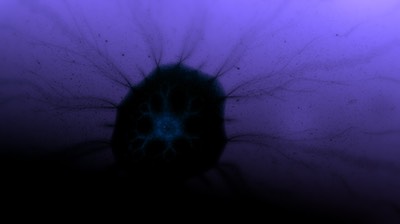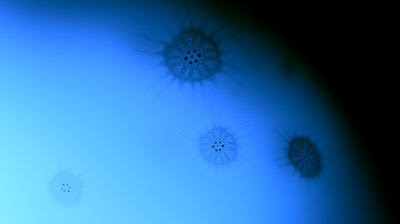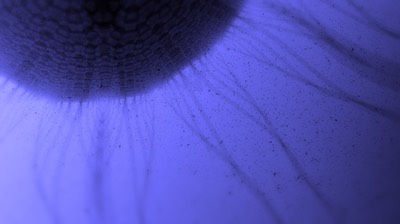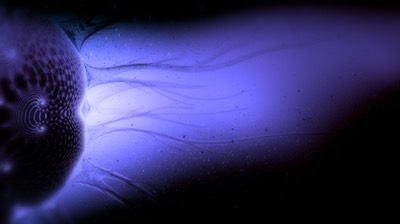Blog Home
Watching Europa iPad Wallpapers
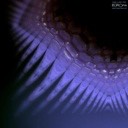
Those of you with iPads might like to check out the iPad wallpapers I've just put up in the shop. They're free, and are designed so that the watermark doesn't appear in either vertical or horizontal viewing aspect of your iPad, giving you a clutter-free and awesomely impressive desktop.
I'll be adding to these over the coming weeks, so be sure to drop by from time to time to see what's new.
Enceladus
NASA's Cassini probe has returned some stunning pictures that show water vapour crystallizing into ice particles as it is ejected under pressure from what is believed to be a 'salty' ocean under the surface of Saturn's small moon Enceladus.
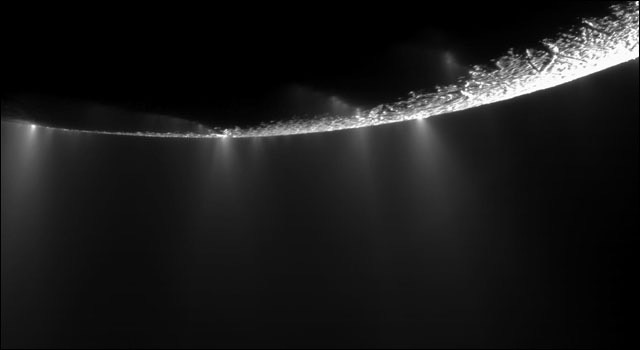
Like Europa, Enceladus is pushed and pulled by the gravity of its planet and it is likely that this tidal flexion is what provides enough heat to maintain liquid water under its icy outer layers. NASA scientists say that the the salt-rich ice particles ejected near the surface have an 'ocean-like' composition, rich in potassium and sodium.
The ice crystal jets come from an area on Enceladus called 'The Tiger Stripes', large rifts over a hundred kilometers long tinged with unusual bluish streaks. What's great here is that the science has determined that the water cannot be simply frozen particles ejected from the surface ice itself - it must come from below it.
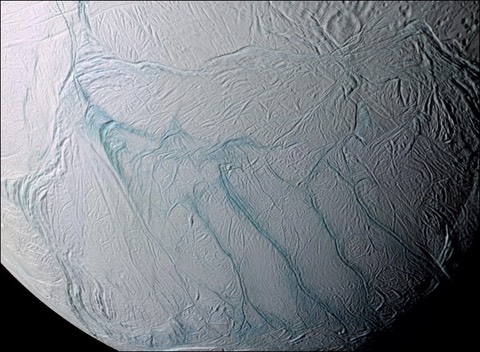
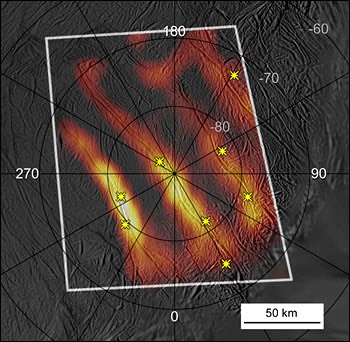
"There currently is no plausible way to produce a steady outflow of salt-rich grains from solid ice across all the tiger stripes other than salt water under Enceladus's icy surface," said Frank Postberg, a Cassini team scientist.
Heat maps of this area show that these rifts are much warmer than the areas that surround them (although it has to be said that the use of the word 'warm' here is relative - the bright areas on the image above right are around -135F, but compared to the -330F of the surface next to them, that's positively balmy!)
The implication of all this is that the ice crust on Enceladus is remarkably thin. In 2008 Cassini sent back data indicating that these fissures on Enceladus are also streaming out a brew of organic chemicals not unlike those found inside comets.
If there is a salty ocean stirred up with organic chemicals on Enceladus, it is certainly a place we would look for evidence of life.
Complexity
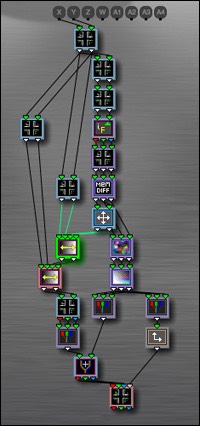
The digital animated images in Watching Europa are not made in the same way as those that you may be accustomed to seeing in the movies. My underwater world is not modelled in 3D and then given transparency and texture through purpose-built descriptors designed especially to emulate water or light. The Europan creatures, likewise, are not built with digital modelling tools that are specifically purposed for imitating real things like jellyfish, or leaves or tentacles.
My canvas is, instead, simply a Cartesian Plane, and all the properties of the world I have made are illusions that arise from interactions of reasonably simple mathematical descriptions. It is true that I have a great deal of control over those descriptions, but an important aspect of my work is to allow a sort of 'wildness' to creep in, in order that an amount of genuine surprise informs the process.
This is possible through a powerful and somewhat counter-intuitive notion: that of non-linearity and complexity. To put it very simply, I can describe some very simple rules for a part of the Europan world but because of the vast number of interactions in my mathematical systems, it is impossible for me (or anyone) to know exactly how those interactions will play out. Not only that, but looking at the end result of those interactions will not allow you to deduce what rules were in play or what they were doing - no matter how simple those rules were.
Of course, complete unfettered randomness would result in total anarchy so I apply some strict conditions to exactly what I allow to 'go wild', and I avoid having rules that I know will destroy the system. Even so, there is enormous novelty available to me, and the methodical exploration of that novelty results in Europan creatures that often surprise and delight me, as I hope would be the reaction if we found real life on Europa.
In a very tangible way, the lifeforms you see in Watching Europa are following similar rule systems to those that probably define actual life. The major difference is that the parameters of my fictional Europan world are established by my input, and the natural world has its constraints imposed by evolution.
The Eerie Silence
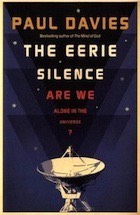
I'm reading Paul Davies 'The Eerie Silence' at the moment.
Davies is a physicist with an ongoing interest in the Big Questions such as the one he addresses in this book: If we are not alone in the universe, where is everyone?
It's a slightly depressing read for someone such as myself who does hold the hope that we are not the only creatures in the cosmos. Davies (unfortunately for optimism) argues fairly persuasively that if intelligent life is pervasive, we should probably already be aware of it - if we're looking in the right places, that is. One of the intriguing things about this book is that Professor Davies, who in 2005 took up the chair of the SETI Post-Detection and Technology Taskgroup, outlines some good reasons why alien intelligence might very well deserve the adjective 'alien'. If other beings exist out there, he reasons, anticipating what they might be like according to our own preconceptions is probably the wrong way to go about finding evidence of them.
Nevertheless, this very level-headed view of ET hunting does serve to strengthen one of the key ideas behind Watching Europa: that discovering signs of extraterrestrial life, even if it is non-intelligent, would be a remarkable and awe-inspiring event.
The Book
Due to some bug hunting in the ArtMatic software I've suspended my animation renders until we figure it out. in the meantime, I'm rendering high resolution stills for the Watching Europa book. Beautiful!
Welcome to Watching Europa
This is where I'll keep you up to date with all the latest on the project, and where all and any discussions are welcome (when I can figure out how to activate the comments!).
